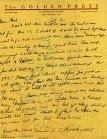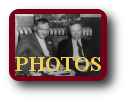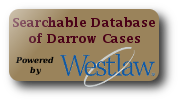The Sweet Trials, Clarence Darrow and Race
"Gentlemen, I ask you to use all of your judgment, all of your understanding, all of your sympathy in the decision of this case. I speak not only for these eleven people, but for a race that in spite of what you may do will go on and on and on to heights that it has never known before. I speak to you not only in behalf of them, but in behalf of the millions of blacks who look to these twelve white faces for confidence and trust and hope in the institutions of our land, and in the guarantees that the laws have made to them, those blacks who all up and down the length and breadth of our land, and whose ancestors we brought here in chains . . . ."
– Closing Argument of Clarence Darrow in the trial of Ossian Sweet et. al., November 24, 1925 (first Sweet trial)."I would like to see a time when man loves his fellow-man, and forgets his color or his creed. We will never be civilized until that time comes. I know the Negro race has a long road to go. I believe the life of the Negro race has been a life of tragedy, of injustice, of oppression. The law had made him equal, but man has not. And, after all, the last analysis is, what has man done? - and not what has the law done?"
– Closing Argument of Clarence Darrow in the trial of Henry Sweet, May 18, 1926 (second Sweet trial).
|
Transcript from the first Sweet trial.
Subpoenas (1925).
Various subpoenas for the first Sweet trial.
Miscellaneous Documents from the Sweet Trial (1925).
Includes list of witnesses, defense demands for separate trials, request for bail and information filed by the prosecutor.
Motion to Quash Information and Discharge Defendants.
Motion filed by Cecil Rowlette, Julian Perry, and Charles Mahoney, three black attorneys who first represented the Sweets and the other defendants.
Closing Argument of Clarence Darrow in the First Sweet Trial.
The People v. Ossian Sweet, Gladys Sweet, et. al. (1925).
Argument of Clarence Darrow in the Case of Henry Sweet.
This is the second Sweet trial. Held in the Recorders Court, Detroit, Michigan before the Honorable Frank Murphy, April and May, 1926.
Trial Transcripts: Closing Arguments in the Henry Sweet trial (2nd Sweet trial).
Partial transcript of the Henry Sweet trial containing closing arguments of Lester Moll (prosecution), Thomas F. Chawke (defense) and Robert Toms (prosecution). Also contains Judge Frank Murphy's instructions to the jury.
Nolle Prosequi.
In June 1927, prosecutor Robert Toms filed this nolle prosequi to drop any further prosecution of the Sweets or the other defendants. Nolle prosequi is Latin for "not to wish to prosecute" and is "A legal notice that a lawsuit or prosecution has been abandoned." Black's Law Dictionary. Toms acknowledged that the state's evidence against Henry Sweet was much stronger than against the other defendants and since Henry Sweet was found not guilty it was not likely the state could prevail against the other defendants - "in view of the proceedings already had in this cause such a result seems improbable to the last degree."
This is an 1860 Michigan Supreme Court case relied on by the defense. The court held that the law does not require that one who kills another in self-defense must be in actual or imminent danger but may do so if the defendant acts under reasonable apprehension of the danger even if later he turns out to have been mistaken. The case also states that, "a man assaulted in his dwelling is not obliged to retreat" and may use force including deadly force to repel the attacker.
Michigan statute that defines twelve or more armed persons or thirty or more unarmed persons unlawfully assembled as an offense against the public peace and directs government officials and police to disperse them. The Sweet defense used this statute to show that the white crowd gathered around Ossian Sweet's home was an unlawful "mob" and the Sweet defendants were justified when they defended themselves. Judge Murphy's instructions to the jury during the Henry Sweet trial incorporated this statute: "If you find that on the night of September 9th, in the vicinity of Dr. Sweet's home, twelve or more persons armed with clubs or other dangerous weapons, or thirty or more, whether armed or not, were assembled for the purpose of violently ejecting Dr. Sweet from his home, or for the purpose of intimidating him by threats so that he would leave his home, then such persons were engaged in an unlawful assembly or riot, even though there was no loud tumult or great confusion."
Michigan Public Acts, 1927 - No. 372.
Michigan gun-control statute enacted after the Sweet trials. Although race neutral on its face it was enacted to keep blacks from owning firearms.
Dr. Ossian Sweet Self-defense Act (2006).
2006 bill which would allow an individual to use deadly force against an attacker with no duty to retreat under certain conditions. It was later amended to remove the name: "Dr. Ossian Sweet Self Defense Act". The amendment passed in the Senate by voice vote on June 6, 2006. The bill passed in the Senate (28 to 10) on June 6, 2006 and passed in the House (90 to 17) on June 27, 2006. It established that a law-abiding person who is attacked in any place where he or she has a right to be has no duty to retreat, and can stand his or her ground and meet force with force, including deadly force if necessary to prevent death or great bodily harm. The vote was 90 in favor, 17 opposed, and 0 not voting. It was signed into law by Gov. Jennifer Granholm on July 18, 2006. The law is titled the "Self-defense Act."
The complaint and criminal warrant against the Sweets and other defendants.
The Negro in Detroit (1926).
Report of the Mayor's Interracial Commission. Mayor John Smith appointed the commission in the aftermath of the murder of Leon Breiner to study the problems of race relations in Detroit.
This article is about ten successful and prominent black citizens; the author and three of the men discussed were friends of Clarence Darrow. W.E.B. Du Bois was a co-founder of the NAACP and was one of the most important black leaders of his day. Edward H. Morris was a prominent Chicago attorney and politician. Daniel Hale Williams was perhaps the most prominent black surgeon of his day, and served as Darrow's personal physician for a time. Charles Waddell Chesnutt was a writer and political activist. From Appleton's The Booklover's Magazine (1903).
National Negro Conference (1910).
Announcement about the second annual conference of the National Negro Committee to be held in New York on May 12-14, 1910. Clarence Darrow spoke at this conference which resulted in the formation of the National Association for the Advancement of Colored People (NAACP).
Clarence Darrow criticized in Watson's Jeffersonian Magazine.
Watson's Magazine criticized Darrow for advocating interracial marriage when Darrow spoke at the second annual conference of the National Negro Committee in New York from May 12-14, 1910. This meeting has been identified as the beginning of the NAACP. Watson's Magazine was owned and edited by Thomas Edward Watson, a U.S. Senator from Georgia from 1920 until his death in 1922. Watson and his publications were very anti-Semite, anti-Catholic and anti-black.
Closing the Little Black Schoolhouse: Second National Negro Conference Results in New Organization by May White Ovington (1910).
The second annual conference of the National Negro Committee took place in New York from May 12-14, 1910. This meeting is often thought to have led to the formation of the National Association for the Advancement of Colored People (NAACP). This report states: "At its business meetings the conference adopted a plan of permanent organization. The committee was to become the National Association for the Advancement of Colored People, with headquarters in New York." However, Mary White Ovington identifies the first conference she attended with William English Walling as the start of the NAACP: "So I wrote to Mr. Walling, and after some time, for he was in the West, we met in New York in the first week of the year of 1909. With us was Dr. Henry Moskowitz, now prominent in the administration of John Purroy Mitchell, Mayor of New York. It was then that the National Association for the Advancement of Colored People was born. It was born in a little room of a New York apartment." How NAACP Began: According to the report of the second annual conference, "[t]he speakers of the white race ranged all the way from a conservative Virginian, Oscar Crosby . . . to the labor champion, Clarence Darrow of Chicago." Darrow shocked many whites when he called for overturning laws barring interracial marriage. NOTE: The author is listed as May White Ovington, but she is most often referred to as Mary White Ovington.
Colored Chicago and Some Chicagoans of Note (1915).
The Crisis, the flagship publication of the NAACP, published this article about prominent blacks in Chicago. The article mentions three individuals who were friends of Clarence Darrow: Oscar DePriest, Dr. Daniel Hale Williams and Jesse Binga.
Negroes Move North (1918).
Article describing migration of blacks from the South to the North. Written by George Edmund Haynes, a professor at Fisk University and the Educational Secretary of the National League on Urban Conditions Among Negroes.
The Case of Samuel Moore (1921).
Editorial in The Crisis about Samuel Moore who was convicted of first degree murder in Washington in 1891 and sentenced to death for killing a white man. President Harrison later commuted the sentence to life in prison. Moore always claimed self defense and his requests for parole were championed by Eugene Debs who for a time was in the same prison. Moore got out of prison in 1927 but was sent back to prison at some point. In September 1942 the 8th Circuit Court of Appeals dismissed Moore's pro se petition for a writ of habeas corpus asking to be dismissed from custody. The court recommended Moore apply for Executive clemency. The court stated "Petitioner is an aged negro who has served more than half a century in prison. He wants to die a free man." At the time of his petition Moore was in the Medical Center for Federal Prisoners in Springfield Missouri. He had been in prison for a total of more than fifty years. Moore wrote several letters to Clarence Darrow's wife Ruby in 1939 and 1940.
Howard, The National University of the Negro Race by Emmet J. Scott (1924).
Short article written by the Secretary-Treasurer of Howard University. Scott says the Medical School is rated as "Class A" institution by the American Medical Association. Ossian Sweet graduated from Howard with a medical degree in 1921. At the time Howard was one of only two black medical schools in the country the other being Meharry Medical College in Nashville.
Newspaper account of speech Clarence Darrow gave to black audience at Y.M.C.A. about Sweet trial and race. Darrow also talked about prohibition.
William Sanders Scarborough was the President of Wilberforce University when Ossian Sweet attended. Scarborough was born into slavery in Macon, Georgia, in 1852. He went on to become the first African American classical scholar. Scarborough served as president of Wilberforce University between 1908 and 1920.
Edward H. Morris.
Short bio of Edward Morris, a black attorney in Illinois. Clarence Darrow was good friends with Morris and worked with him in 1917 to defend Oscar DePriest a black Chicago politician on trial for conspiracy charges relating to gambling and prostitution. In November 1923, Darrow wrote a letter to the editor of The Broad Ax, a black Chicago newspaper, strongly protesting a report from a committee of the Chicago Bar on candidates for judges. The report stated that Morris was not fit for the bench and also mentioned that he was a "colored man." Darrow accused the committee of being prompted "solely" by Morris' color and praised his ability.
Biographical Sketch of Honorable Ossian B. Hart, Late Governor of Florida, 1873.
Ossian Sweet was named in honor of Ossian B. Hart a white progressive Republican Governor of Florida who fostered good relation with black citizens in Florida. Ossian's oldest brother, who died in infancy, had been named after Ossian B. Hart's brother.
The Problem of the Negro by Clarence Darrow.
Address by Clarence Darrow before a mostly African-American audience at the Men's Club in Chicago on Sunday, May 19, 1901. Published in The International Socialist Review.
The Talented Tenth by W.E.B. DuBois.
1903 essay by DuBois explaining his theory that a talented group of educated blacks was needed to lead their race to social equality. DuBois began his essay with "The Negro race, like all races, is going to be saved by its exceptional men." Ossian Sweet became deeply immersed in DuBois's message and saw himself as part of this "talented tenth." Published in The Negro Problem: A Series of Articles by Representative American Negroes of Today by Booker T. Washington (1903).
The Disfranchisement of the Negro by Charles W. Chesnutt (1903).
Charles Waddell Chesnutt (1858 - 1932) was an African-American author, essayist and political activist. Chesnutt wrote a letter to Darrow in 1907 to thank him for sending a copy of a speech Darrow gave at the Bethel Church in Chicago in December 1906 about blacks and racism. This article about "Disfranchisement" was published in The Negro Problem: A Series of Articles by Representative American Negroes of Today by Booker T. Washington.
The Negro Problem: A Series of Articles by Representative American Negroes of To-day (1903).
Contributions by Booker T. Washington, William Edward Burghardt Du Bois, C. W. Chesnutt, W. H. Smith, H. T. Keeling, P. L. Dunbar, and T. T. Fortune.
National Conference on the Status of the American Negro.
An announcement for a two-day conference to be held in New York starting May 31, 1909 was published in The Survey by the Charitable Organization Society. Although it would not take on the name immediately, this conference was actually the first meeting after the formation of the National Association for the Advancement of Colored People (NAACP). This announcement states that among those giving an address would be Clarence Darrow.
Proceedings of the National Negro Conference 1909.
Held in New York May 31 - June 1, 1909.
Howard University Medical College.
Brief description of Howard University Medical College based on a 1910 inspection. From Medical Education in the United States and Canada: A Report to the Carnegie Foundation for the Advancement of Teaching.
Half a Man: The Status of the Negro in New York by Mary White Ovington (1911).
Mary White Ovington was a co-founder of the NAACP.
Three Spiritual Leaders of the American Negro (1913).
Excerpt about William S. Scarborough of Wilberforce University. Published in the The African Abroad: Or, His Evolution in Western Civilization, Tracing His Development Under Caucasian Milieu by William Henry Ferris.
The Party of Freedom and the Freedmen--A Reciprocal Duty by William Sanders Scarborough.
Address delivered at the Lincoln Day Banquet, Dayton, Ohio, February 11, 1899. William Sanders Scarborough was President of Wilberforce University. Published in Masterpieces of Negro Eloquence: The Best Speeches Delivered by the Negro from the Days of Slavery to the Present Time by Alice Moore Dunbar-Nelson.
William Lloyd Garrison: A Centennial Oration by Reverdy C. Ransom, D.D. (1914).
Reverdy C. Ransom was a good friend of Clarence Darrow. Published in Masterpieces of Negro Eloquence: The Best Speeches Delivered by the Negro from the Days of Slavery to the Present Time by Alice Moore Dunbar-Nelson.
History and Report of the Exhibition and Celebration to Commemorate the Fiftieth Anniversary of the Emancipation of the Negro.
Clarence Darrow and many others were named Honorary Vice Presidents for this celebration held at the Coliseum in Chicago from August 22 to September 16, 1915.
Howard University.
Brief description of Howard University based on visits in 1915. Published in Negro Education: A Study of the Private and Higher Schools for Colored People in the United States by the United States Office of Education.
Wilberforce University.
Overview of Wilberforce University based on a 1915 site visit published in Negro Education: A Study of the Private and Higher Schools for Colored People in the United States by the United States Office of Education.
Reverdy C. Ransom, of the A.M.E. Church (1918).
Excerpt from The Negro in Literature and Art referring to Reverdy Ransom. Clarence Darrow and Ransom were friends and worked together to settle a labor strike in Chicago.
History of Wilberforce University (1918).
Brief history published in History of Greene County, Ohio: Its People, Industries and Institutions by Michael A. Broadstone.
List of students in Howard University Medical School in 1918.
Ossian Sweet is listed as a freshman on page four. The list, from the Catalogue of Howard University, includes students in the medical, dental and pharmaceutic colleges.
Catalogue Howard University 1917-1918.
Ossian Sweet is listed on page 261 of this catalog of the officers and students of Howard University during 1917-1918, the year that Sweet was a freshman medical student. The catalog also provides information about Howard University.
Educational Problems by Reverdy C. Ransom (1921).
Excerpts from an address given in June 1921. Clarence Darrow was a friend of Reverdy Ransom.
The Founding of Howard University by Walter Dyson (1921).
Written just after Ossian Sweet graduated from Howard University School of Medicine.
Clarence Darrow Tells Negro Audience to Maintain Attitude of Defiance Toward White Men (1927).
Critical description of a speech given by Clarence Darrow before a black audience in Baldwin, Alabama.
Samuel Moore Letters.
Samuel Moore, an African-American prisoner in the Federal Penitentiary in Atlanta, wrote these letters to Ruby Darrow in 1939 and 1940.
From: Moore, Samuel To: Darrow, Ruby Jun 3, 1939
Proceedings in the Supreme Court of the United States In Memory of Mr. Justice Murphy (1951).
Resolutions adopted in memory of Justice Frank Murphy.
Photos
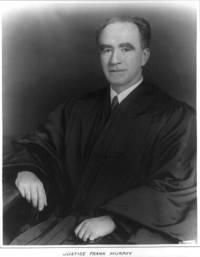 Justice Frank Murphy. Justice Frank Murphy (1890 - 1949) was the trial judge in both Sweet trials. Clarence Darrow wrote in his autobiography The Story of My Life: "When I went to court to arrange for the trial, I found a judge who not only seemed human, but who proved to be the kindliest and most understanding man I have ever happened to meet on the bench, Judge Frank Murphy . . . ." Library of Congress Prints and Photographs Division, LC-USZ62-47787. |
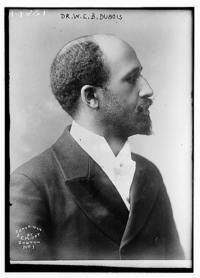 William Edward Burghardt ("W.E.B.") Du Bois. According to Du Bois, there were two factors that distinguished the Sweet trials from other trials involving blacks during this time period: "First, the American Negro went down in his pocket and for the first time in his history put into the treasury of the N.A.A.C.P. an amount of money that meant that these defendants would have a chance for a fair trial. Justice in the United States costs money. No pauper need apply at the barred gates of our criminal courts. Secondly, we found in Clarence Darrow a man who dared; whose whole life has been daring; who has had the rare moral courage to stand and defend, with his singular sincerity, unpopular causes." Michael J. Klarman, The Racial Origins of Modern Criminal Procedure, 99 MICH. L. REV. 48, 90 (2000). Library of Congress Prints and Photographs Division, LC-USZ62-28485. |
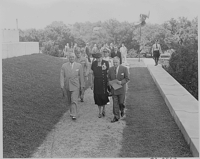 Walter White. Walter Francis White (1893 - 1955) served as the executive secretary of the National Association for the Advancement of Colored People (N.A.A.C.P.) from 1931 - 1955. This photo is from an address given by President Truman at the closing session of the 38th annual conference of the N.A.A.C.P. at Lincoln Memorial in Washington, D. C. L to R: President Truman, Gen. Harry Vaughan (in back), Mrs. Eleanor Roosevelt, Captain James Foskett (in back), and Walter White. National Archives and Records Administration, ARC Identifier 199721. |
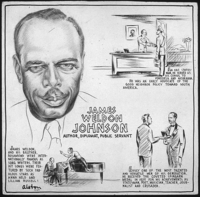 James Weldon Johnson. Work entitled: JAMES WELDON JOHNSON - AUTHOR, DIPLOMAT, PUBLIC SERVANT, 1943. Created by African-American artist Charles Henry Alston. National Archives and Records Administration, ARC Identifier: 535623 Local Identifier: 208-COM-79. |
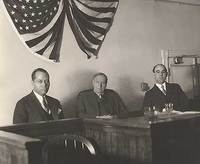 Charles Hamilton Houston, Clarence Darrow, and Mordecai Johnson. Charles Houston Hamilton was Dean of Howard University Law School. Mordecai Johnson, the first African American president of Howard University, named Houston to head the law school in 1929. Houston got Clarence Darrow and other prominent lawyers to lecture at Howard University Law School. Photo from the Scurlock Studio Records, Archives Center, National Museum of American History, Smithsonian Institution. |
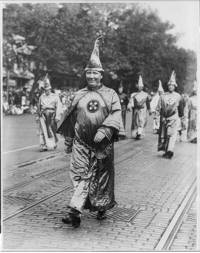 H.W. Evans. Dr. H.W. Evans, Imperial Wizard of the Ku Klux Klan, leading his Knights of the Klan in the parade held in Washington, D.C. Hiram Wesley Evans (1881 - 1966) was Imperial Wizard of the Ku Klux Klan from 1922 until 1939. In 1931 Clarence Darrow helped defend David Curtiss "D. C." Stephenson (1891 - 1966), former Grand Dragon of the Indiana Ku Klux Klan and 22 other northern states, who was appealing a murder conviction. Stephenson was convicted for kidnapping and murdering Madge Oberholtzer, a 28 year-old schoolteacher in 1925. Stephenson and Darrow corresponded by letter between 1928 and 1931 while Stephenson was incarcerated at the Indiana State Prison in Michigan City, Indiana. Newspapers reported that on July 7, 1931 Darrow had joined Stephenson's defense. In his letters to Darrow Stephenson claimed H.W. Evans committed the murder and framed Stephenson. Library of Congress Prints and Photographs Division, LC-USZ62-61303. |
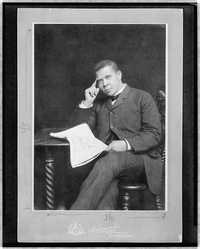 Booker T. Washington. Booker Taliaferro Washington (1856 - 1915) was a very prominent black educator, speaker, and writer. He most remembered as one of the most important national leaders of the African-American community. He was born into slavery because his mother was a slave although his father was white. He was freed by the Civil War in 1865. He later became head of the new Tuskegee Institute in Alabama which was then a teachers' college for blacks. Washington advocated a conservative approach to racial equality that emphasized the importance for blacks to earn a practical education and learn job skills instead of demanding full equality. There was a sharp divide between Washington and other black leaders such as William Du Bois who thought Washington was accommodating racism and hindering the quest for racial equality. Clarence Darrow sided with Du Bois instead of Washington: "The path before the colored race is very long and very hard. The first thing to find out is what are you really going to do. I have felt very many times that Booker T. Washington was not on the right path, and I would not say this too positively because I know how devoted he is to the cause of the colored people, and I believe he is honest and sincere, but I want to tell you why I have felt many times that he is not on the right track, and in this I, too, may be wrong, and I may not fairly estimate Washington." The Problem of the Negro, speech given by Clarence Darrow to African-American audience in Chicago, May 19, 1901. Library of Congress Prints and Photographs Division, LC-USZ62-119897. |
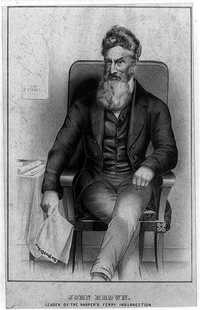 John Brown. John Brown (1800 - 1859) was the most notorious and controversial abolitionists in the history of the United States. Brown despised slavery and believed in direct action to abolish it. In May 1856 he and his supporters killed five pro-slavery southerners in Kansas in an attack that came to be known as the Pottawatomie Massacre. On October 16, 1859, Brown led 21 men on a raid of the federal arsenal at Harpers Ferry, Virginia. Brown planned to seize weapons from the arsenal and arm slaves to start an insurrection to end slavery. But the raid ended in failure when Marines led by Robert E. Lee along with local farmers and militiamen killed or captured most of Brown's men. Brown was seriously wounded. He was tried and convicted of treason and sentenced to death. Brown was hanged on December 2, 1859. The raid on Harpers Ferry was a major factor leading to the Civil War in 1862. Clarence Darrow was a great admirer of John Brown and often gave a lecture about him. However a myth has grown from an erroneous account by Irving Stone in his biography of Darrow. Stone wrote that the abolitionist John Brown came to Kinsman to confer with Amirus Darrow and that Brown laid his hand on the then five year old Clarence Darrow and told him "The Negro has too few friends; you and I must never desert him." Several sources have pointed it out this cannot be true because Brown was hanged in 1859 when Clarence was two years old. However, Ohio was an important part of the Underground Railroad which went through the area where the Darrow family lived. This area was strongly abolitionist and Brown got his men ready for the raid on Harpers Ferry in West Andover, Ohio which is about fifteen miles from Kinsman where the Darrow family lived. So it is possible that Amirus Darrow, who was an abolitionist, met Brown at some point. Library of Congress Prints and Photographs Division, LC-USZ62-89569. |
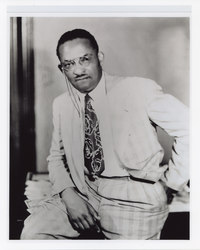 Dr. Ossian Sweet. Significantly the defense convinced Judge Murphy to allow Ossian Sweet to testify about his early experiences with racial discrimination and violence and about stories his grandfather told him about racism. The defense needed to show that Ossian and the other defendants feared for their lives in order to successfully argue self defense. During the first trial, Arthur Garfield Hays had Ossian describe the mob scene in front of his house on September 9, 1925 and then asked what his state of mind was at the time of the shooting. Ossian answered: "When I opened the door and saw the mob, I realized I was facing the same mob that had hounded my people through its entire history. In my mind I was pretty confident of what I was up against, with my back against the wall. I was filled with a peculiar fear, the fear of one who knows the history of my race." Prosecutor Lester Moll later commented that "Dr. Sweet's testimony was the turning point in the trial." Photo courtesy of the Burton Historical Collection, Detroit Public Library. |
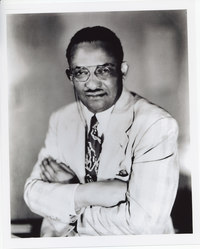 Dr. Ossian Sweet. Ossian Sweet (1895 - 1960) was born in Orlando, Florida. His family later moved to Bartow, Florida. He was named after a Reconstruction-era governor, Ossian B. Hart, who had appointed an uncle of Ossian's mother to the position of Justice of the Peace in 1873. In 1909, at age 13, Ossian traveled to Xenia Ohio to attend Wilberforce University. He graduated from Wilberforce and in 1917 was accepted to Howard University medical school. He graduated from Howard with a medical degree in 1921 and then moved to Detroit as a new doctor. In November 1921 he passed the Michigan state medical exam. Photo courtesy of the Burton Historical Collection, Detroit Public Library. |
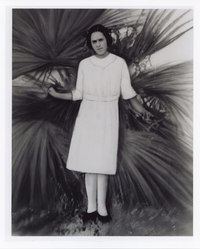 Gladys Sweet. Gladys was Ossian Sweet's wife. She was arrested and charged with murder along with the other defendants who were present in the Sweet's house on the evening of the shooting. Photo courtesy of the Burton Historical Collection, Detroit Public Library. |
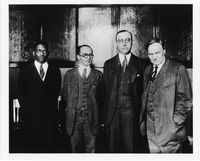 Henry Sweet, Julian Perry, Thomas Chawke, Clarence Darrow. Henry Sweet, a younger brother of Ossian Sweet, was the sole defendant in the second trial. Henry was the only defendant to admit to firing a gun on the night of the murder. Perry and Chawke were associate defense counsel. Photo courtesy of the Burton Historical Collection, Detroit Public Library. |
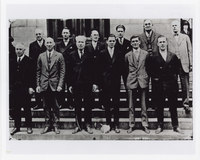 Jury in the Henry Sweet Murder Trial. Jurors in the second Sweet trial in which Henry Sweet, the brother of Ossian Sweet was tried by himself for murder. Henry was the only defendant to admit that he fired shots that night. The trial was held from April 19 to May 13, 1926. Top Row (right to left): Charles Thorne, William B. Brunswick, Edward W. Bernie, John M. Allen, James S. Spencer, Charles Phillips. Bottom Row (right to left): Charles L. Dann, Ralph Fuelling, George C. Small (jury foreman), Richard Adams, William J. Simpson, Lewis J. Sutton. Photo courtesy of the Burton Historical Collection, Detroit Public Library. |
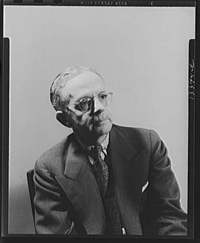 Walter White, Executive Secretary of the National Association for the Advancement of Colored People. In 1925 Walter White was an assistant secretary of the NAACP. White was instrumental in hiring Clarence Darrow to defend the Sweets and the other defendants. By the time White arrived in Detroit, the defendants had already hired three black attorneys. White informed the black attorneys that it was the position of the NAACP''s national office that a white attorney "of the very highest standing should be retained at once" because even the "fairest-minded white citizens" of Detroit believed that the defendants had fired and killed a man without provocation. August Meier & Elliott Rudwick, Attorneys Black and White: A Case Study of Race Relations within the NAACP, 62 THE JOURNAL OF AMERICAN HISTORY 913, 930 (1976). Library of Congress Prints and Photographs Division, LC-USF34-013344-C. |
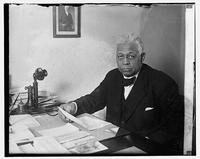 Oscar DePriest. Oscar Stanton DePriest (1871 - 1951) was born in Florence, Alabama to former slaves. He moved to Chicago in 1889. He was the first African-American elected to city council in Chicago and he served as an alderman for the 2nd Ward from 1915 to 1917. He resigned from this position in 1917 after being indicted for protecting South Side gamblers. DePriest hired Clarence Darrow to defend him and he was acquitted. He later served as a U.S. Representative from Illinois from 1929 to 1935. He was the first African-American to serve in Congress in the 20th century. LC-DIG-npcc-17479, Library of Congress Prints and Photographs Division. DePriest Letter to Darrow. |
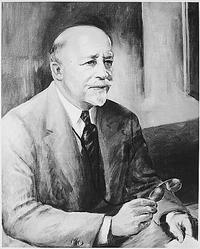 W.E.B. DuBois. National Archives and Records Administration, ARC Identifier 559200. |
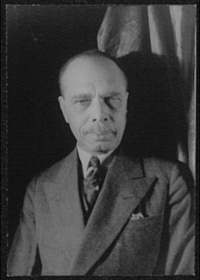 James Weldon Johnson. James Weldon Johnson, Executive Secretary of the NAACP, described the end of Clarence Darrow's closing argument in the Henry Sweet trial: "He closed his argument with an appeal that did not leave a dry eye in the courtroom. When he finished I walked over to him to express in behalf of the National Association for the Advancement of Colored People my appreciation and thanks. His eyes were shining and wet. He placed his hands on my shoulders. I stammered out a few words but broke down and wept, and I was not ashamed of my tears." James Weldon Johnson & Sondra K. Wilson, The Selected Writings of James Weldon Johnson: Social, Political, and Literary Essays, 87 (1995). Library of Congress Prints and Photographs Division, LC-USZ62-42498. |
 Daniel Hale Williams c. 1900. Daniel Hale Williams (1856 - 1931) was an American surgeon and is considered to be the first African-American cardiologist. For a time, Williams was Clarence Darrow''s personal physician. Williams is credited with performing one of the first successful heart surgeries in 1893. He also founded Provident Hospital, the first non-segregated hospital in the United States in Chicago in 1891. Williams graduated from Chicago Medical College of Northwestern University in 1883. Other honors Williams earned include: surgeon-in-chief of the Freedman''s Hospital in Washington, D.C. from 1883-1898; first African-American member of the American College of Surgeons; and professor of clinical surgery at Meharry Medical College in Nashville Tennessee. When Ossian Sweet decided to become a doctor there were only about 2,500 black doctors in the United States. Dr. Williams was one of the most famous. http://en.wikipedia.org /wiki/File:Daniel_ Hale_Williams.jpg |
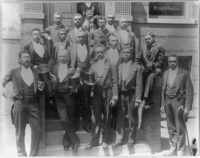 Graduating Class at Howard University School of Law, Washington, D.C. [ca. 1900]. Charles Hamilton Houston, vice-dean of Howard University Law School from 1929 until 1935, was instrumental in forming the legal strategy that led to the Brown v. Board of Education decision. Houston built Howard law school into a first rate program, in part, by engaging guest lecturers such as Dean Roscoe Pound of Harvard Law School and Clarence Darrow. Howard Law School was accredited by the American Bar Association in 1931. Library of Congress Prints and Photographs Division, LC-USZ62-35752. |
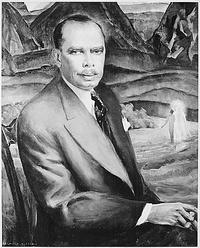 James Weldon Johnson. Executive Secretary of the N.A.A.C.P. James Weldon Johnson stated after the Henry Sweet trial: "The verdict was recorded upon the oath of the jury and thus was reached what we believe to be the end of the most dramatic court trial involving the fundamental rights of the Negro in his whole history in this country." James Weldon Johnson, Detroit, 32 The Crisis 117, 120 (1926). Laura W. Waring, Artist. National Archives and Records Administration. ARC Identifier 559201 / Local Identifier H-HNP-24. |
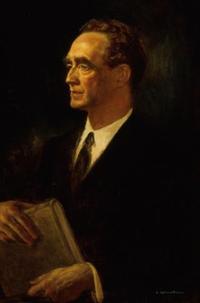 Justice Frank Murphy. Frank Murphy was a judge in the Recorder's Court of the City of Detroit from 1923 to 1930 and the trial judge in the Sweet trials. Judge Murphy was very sympathetic to the defense. He made a key ruling by allowing the defense to introduce testimony from Ossian Sweet about specific acts of racism he had seen and experienced as a child or had heard about from his grandfather who told him about slavery, and how these experiences created fear in Ossian. Without this testimony the prosecution could argue that the defendants were not sufficiently in fear to justify self defense. Clarence Darrow wrote in The Story of My Life: "A man who practices law in the criminal courts should be able to tell something about a man by looking at his face. A large part of his work is sizing up judges, jurors, and witnesses at the first glance. At any rate, I did not take a change of venue from Judge Frank Murphy, and an extended and rather close association with him convinced me that I was not mistaken in him." Portrait from the Collection of the Supreme Court of the United States (Artist: Elek Kanarek). |
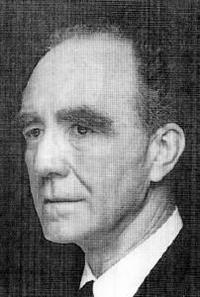 Justice Frank Murphy. After the Sweet trials, Frank Murphy went on to serve as Mayor of Detroit, Governor of Michigan, the last Governor-General of the Philippines and the first High Commissioner of the Philippines, United States Attorney General, and United States Supreme Court Justice. |
 Moncure Daniel Conway. Moncure Daniel Conway (1832 - 1907) was an abolitionist, Unitarian clergyman and author. Conway was born into a slaveholding family but later became an outspoken abolitionist. In 1862 Conway helped lead his father's slaves, who had escaped to Washington during the war, to freedom in Ohio. On May 19, 1901 Clarence Darrow gave a speech to a black audience at the Men’s Club in Chicago titled “The Problem of the Negro.” He told the audience that during the previous week he had conversations with two men about the race question: “The first was born in Virginia upon a plantation, and knew what slavery was - he is one of the ablest men in the United States, a man who has given his whole life to the cause of human liberty -- Mr. Moncure D. Conway. Beginning life as a Methodist minister, he graduated from that to a Congregational minister, and from that he graduated out of all the churches. He had the spirit of abolitionism and, while he was the son of a slaveholder, born with the slaves, he did not believe in slavery. He entered the cause of abolitionism way back when John Brown entered it; he entered it with Wendell Phillips, with William Lloyd Garrison, with Henry Ward Beecher, and with all the great men who made the cause of abolitionism famous, and I may say sacred, as a great cause for human liberty.” http://en.wikipedia.org/wiki/ File:Moncure_Daniel_Conway.jpg |
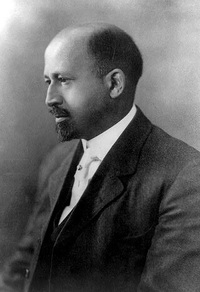 W.E.B. Du Bois. William Edward Burghardt Du Bois, most commonly referred to as W.E.B. Du Bois, was one of most important black leaders of his time. His call for a "The Talented Tenth" of highly educated black men to assume leadership roles for their race inspired Ossian Sweet. |
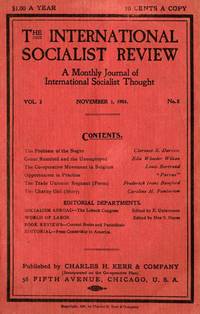 The Problem of the Negro by Clarence Darrow. Cover from an issue of The International Socialist Review that printed a lecture delivered by Clarence Darrow to a mostly African-American audience at the Men's Club in Chicago on May 19, 1901. Full-text available above. |
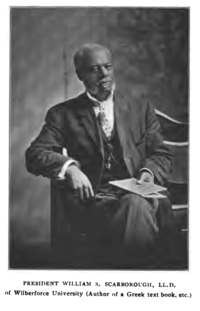 William S. Scarborough 1852 - 1926. William Sanders Scarborough was president of Wilberforce University from 1908 to 1920 which included the time that Ossian Sweet attended. Scarborough was born into slavery in Macon, Georgia, in 1852. He went on to become the first African American classical scholar. |
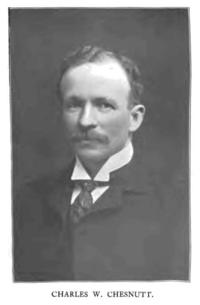 Charles W. Chesnutt. Charles Waddell Chesnutt (1858 - 1932) was an African-American author, essayist and political activist. In 1907 he wrote a letter to Clarence Darrow thanking him for sending a copy of a speech Darrow gave about blacks and racism at the Bethel Church in Chicago in December 1906. Photo is from The Negro Problem: A Series of Articles by Representative American Negroes of Today by Booker T. Washington (1903). Chesnutt Letter to Darrow |
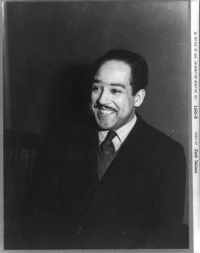 Langston Hughes. Langston Hughes (1902 - 1967) was an African-American writer and playwright associated with the Harlem Renaissance. In his book Fight For Freedom: The Story Of The NAACP (1962) Hughes stated that Clarence Darrow's closing argument in the Henry Sweet trial "has been called one of the greatest in the history of American jurisprudence." Library of Congress Prints and Photographs Division, LC-USZ62-43605. |
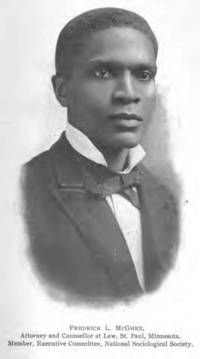 Fredrick L. McGhee. Clarence Darrow was friends with Edward H. Morris one of most successful black attorneys in Chicago and who earned the compliment the "dean of colored lawyers." Morris was a mentor to several young black law lawyers and law students including Fredrick L. McGhee (1861 - 1912) who was born into slavery. In 1885, at the age of twenty-four, McGhee went into practice with Morris. McGhee later moved to St. Paul, Minnesota and became the first black lawyer admitted to the bar in Minnesota. McGhee went onto become an important civil rights advocate. He was a co-founder, with W.E.B. Dubois and others, of the "Niagara Movement," the forerunner of the NAACP. Photo from How to Solve the Race Problem: The Proceedings of the Washington Conference on the Race Problem in the United States by Jesse Lawson, National Sociological Society (1904). |
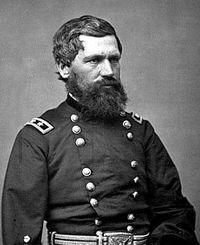 Major General Oliver O. Howard, the Namesake of Howard University. Howard was a Civil War hero, a founder of Howard University, and commissioner of the Freedman's Bureau. CREDIT: Brady National Photographic Art Gallery, photographer. Portrait of Major General Oliver O. Howard, Officer of the Federal Army. Between 1860 and 1865. Selected Civil War Photographs, 1861-1865, Prints and Photographs Division, Library of Congress. |
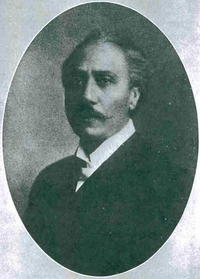 Reverend Reverdy C. Ransom. Reverdy Cassius Ransom (1861 - 1959) was a black Christian socialist, civil rights activist, and Methodist Bishop. Ransom was a leading figure in what has been termed the "Social Gospel Movement." While working in Chicago, Ransom came in contact with whites, who were involved in settlement house and charity organizations. Through these contacts he came to know Clarence Darrow and the two became friends. Courtesy of: Payne Theological Seminary. |
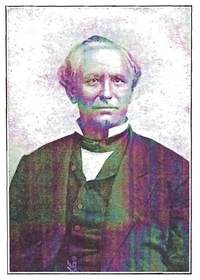 Ossian B. Hart. Ossian B. Hart (1821 - 1874) a Republican, was the tenth governor of Florida serving from January 1873 until his death on March 18, 1874. Ossian Sweet was named in honor of Ossian Hart, a progressive who had good relations with black citizens in Florida. Ossian's Sweet's oldest brother, who died in infancy, was named after Ossian Hart's brother. |
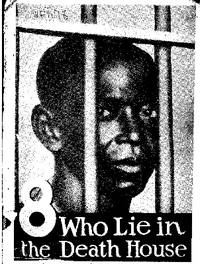 The Scottsboro Boys, by Angelo Herndon. One of the most infamous cases involving racial prejudice in the history of the United States was the legal travesty inflicted on the "Scottsboro boys" the name given to nine young blacks falsely accused of raping two white women on a freight train in Alabama on March 25, 1931. Soon after the alleged attack, they were arrested and taken to jail in Scottsboro, Alabama. They were to be tried for rape for which they could be executed. Clarence Darrow and Arthur Garfield Hays agreed to defend the accused on behalf of the NAACP. However, the Communist Party through its legal branch, the International Labor Defense (ILD), wanted to use the case as propaganda to discredit the United States which setup a battle between the NAACP and the ILD to see who would represent the defendants. The defendants, intimidated and fearing for the lives, asserted that they wanted the ILD to represent them. The ILD told Darrow and Hays they could participate in the defense but they had to repudiate the NAACP and abide by the ILD's legal strategy. Darrow and Hays refused these conditions and withdrew from the case. According to one of his biographers, it was the only case Darrow withdrew from in his career. Credit: Michigan State University Library, Special Collections Division. |
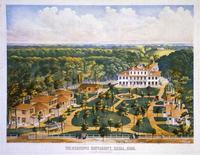 Wilberforce University, Xenia, Ohio c. 1850 - 1860. Ossian Sweet attended Wilberforce University and earned a bachelor of science degree. Named in honor of the famous 18th century British abolitionist, William Wilberforce, it is the oldest private, historically black university in the United States. Xenia is about 21 miles from Dayton and Cincinnati, Ohio. Library of Congress Prints and Photographs Division, LC-USZC4-3406. |
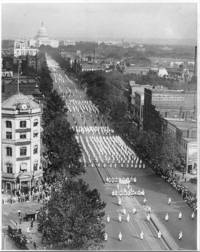 Ku Klux Klan Parade on Pennsylvania Avenue, Washington, D.C. Racial hostility became much worse in Detroit in the 1920s as the Ku Klux Klan rapidly gained considerable influence. Klan membership grew from about 3,000 in 1921 to about 22,000 by 1923. Walter White, at the time an assistant secretary of the NAACP, stated that "in the two years prior to 1925, 90 percent of the new recruits to the Detroit police force were southern whites, susceptible to Klan propaganda." During a special election for mayor held in November 1924 the Klan backed Charles Bowles. Bowles and his Klan backers were not very adept at politics and failed to get his name on the ballot in time, so Bowles had to run as a write-in candidate. Bowles lost the race to Johnny Smith, a Catholic, but it was a fairly close contest. Significantly, Smith's political connections enabled his campaign to get about seventeen thousand ballots rejected because of mistakes made in spelling Bowles' name. Bowles would have won if the ballots were not rejected. Since the 1924 race was a special election, a regular mayoral election was held in November 1925. Jury selection for the first Sweet trial went on during this tense election. The election was held on November 3, 1925, with Johnny Smith again facing Charles Bowles, who the Klan supported. Smith won again by a vote of 140,000 to 110,000. Jury selection ended the next day. The Klan's influence in Detroit began to collapse after this. Library of Congress Prints and Photographs Division, LC-USZ62-59666. |
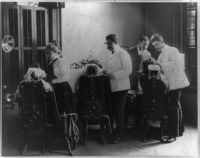 Dentistry at Howard University, Washington, D.C., ca. 1900. John M. Latting was one of the eleven defendants in the first Sweet trial. Latting was a friend of Henry Sweet, the younger brother of Ossian Sweet and he was helping Ossian and his wife move into their new house when he was caught up in the ensuing events. Dr. Latting graduated from Wilberforce University in 1927 and earned a degree in dentistry from Howard University in 1932. Library of Congress Prints and Photographs Division, LC-USZ62-35751. |
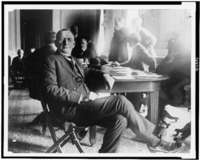 Colonel William Joseph Simmons, Seated at Table During House Committee investigation of the Ku Klux Klan. Simmons was the founder of the second Ku Klux Klan on Thanksgiving Night of 1915 on Stone Mountain, a granite dome, in Stone Mountain, Georgia. Library of Congress Prints and Photographs Division, LC-USZ62-104018. |
 Riot at the Sojourner Truth Homes, a Federal Housing Project Detroit, Michigan, 1942. Riot precipitated by whites attempting to prevent Negroes from occupying U.S. Federal Defense housing project. Tenants were moved in under police escort. Sign with American flag "We want white tenants in our white community," directly opposite the housing project. Library of Congress Prints and Photographs Division, LC-USW3-016549-C. |
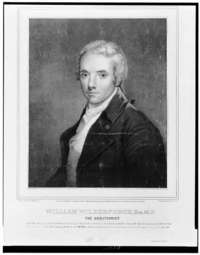 William Wilberforce. William Wilberforce (1759 - 1833) was a British politician, philanthropist and one of the most important leaders of the movement to abolish the slave trade. Ossian Sweet attended and graduated from Wilberforce University which was named in honor of William Wilberforce. It is the nation''s oldest private, historically black university. Library of Congress Prints and Photographs Division, LC-USZ62-117450. |
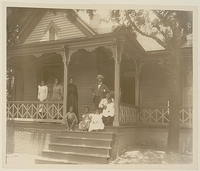 Home of an African American Lawyer, Atlanta, Georgia [1899 or 1900]. In 1930, blacks formed only about .8 percent of the attorneys in the United States with the number in the South even lower. Because of this white lawyers were critical to the NAACP in its first two decades. Before 1930, prominent white lawyers handled most of the NAACP's legal activity. Photos from album: Negro life in Georgia, U.S.A., compiled and prepared by W.E.B. Du Bois, v. 4, no. 352. PART OF: Du Bois, W. E. B. (William Edward Burghardt), 1868-1963. Du Bois albums of photographs of African Americans in Georgia exhibited at the Paris Exposition Universelle in 1900. Library of Congress Prints and Photographs Division,LC-DIG-ppmsca-08768. |
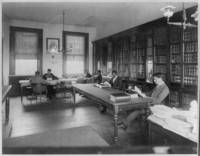 Law Library, Howard University Washington, D.C., ca. 1900. Library of Congress Prints and Photographs Division, LC-USZ62-40468. |
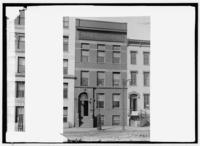 Howard University Law School [between 1909 and 1919]. This row house in downtown Washington was the original home of the Howard University Law School when Charles Hamilton Houston was dean. Houston created demanding academic standards, brought in prominent lawyers to give lectures and instilled in his students a strong sense of mission to use law to end racial discrimination. Clarence Darrow lectured at Howard University Law School. Library of Congress Prints and Photographs Division, LC-DIG-npcc-19248. |
 Pharmaceutical Laboratory at Howard University, Washington, D.C., c. 1900. Library of Congress Prints and Photographs Division, LC-USZ62-35750. |
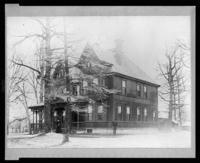 Home of Professor William S. Scarborough of Wilberforce University c. 1899. "Photograph shows exterior view of large house with many leafless trees around it; a man, possibly Prof. William S. Scarborough, and a woman stand in front." Photograph from the American Negro exhibit at the Exposition universelle internationale de 1900. Library of Congress Prints and Photographs Division, LC-USZ62-132533. |
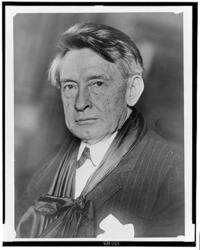 Senator Thomas Edward Watson of Georgia. Watson was a United States Senator from 1920 until his death in 1922. He was the editor of Watson's Magazine and Watson's Jeffersonian Magazine. Watson and his publications were very anti-Semite, anti-Catholic and anti-black. Watson's Magazine severely criticized Clarence Darrow for advocating interracial marriage when Darrow spoke at the second annual conference of the National Negro Committee in New York on May 12-14, 1910. This meeting has been identified as the beginning of the NAACP. Library of Congress Prints and Photographs Division, LC-USZ62-130993. |
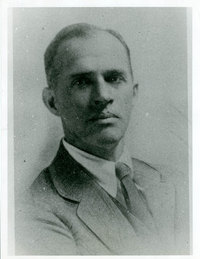 William English Walling. William English Walling (1877 - 1936) was a co-founder of the NAACP. Walling and Clarence Darrow corresponded by letter. Courtesy of the Kentucky Commission on Human Rights |
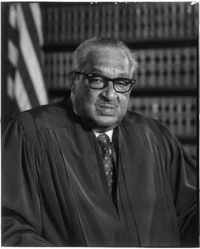 United States Supreme Court Justice Thurgood Marshall. In an article he wrote in 1950 when he was Special Counsel to the NAACP Marshall stated that the Sweet trials "will always be remembered for the brilliant defense conducted by Clarence Darrow and the complete fairness of Judge Frank Murphy." Thurgood Marshall, Mr. Justice Murphy and Civil Rights, 48 MICH. L. REV. 745 (1950). Library of Congress Prints and Photographs Division Washington, LC-USZC6-26. |
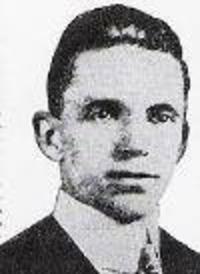 Leon Breiner. Leon Breiner was the murder victim who was shot by someone in the Sweet home. The prosecution made much of the fact that Breiner had been shot in the lower back while standing across the street from the Sweet's house smoking a pipe. During the trial, the prosecution said Darrow was afraid to talk about the victim. But Darrow refused to avoid criticizing Breiner. In the trial of Henry Sweet he told the jury: "I am going to talk about him, and it isn't easy, either. It isn't easy to talk about the dead, unless you "slobber" over them and I am not going to "slobber" over Breiner." In both trials he accused Breiner of being part of the white mob trying to drive the Sweets from their home. |
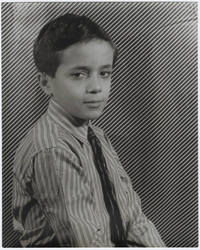 Carl Darrow White. Walter White was the assistant secretary of the NAACP during the Sweet trials and later served as executive secretary of the NAACP from 1931 to 1955. White and Clarence Darrow were good friends. Before White and his wife Gladys had a son in 1927, Clarence and Ruby Darrow told the Whites that they wanted the baby to be their namesake. The Whites agreed and when the baby was born in June he was given the name Walter Carl Darrow White - a combination of names from his father, Clarence Darrow and Carl Van Vechten, a white literary critic, novelist and patron of the Harlem Renaissance. Years later, after a falling out with his father the son changed his name to just Carl Darrow. Carl Darrow was commonly called "Pidge." Photograph by Carl Van Vechten. Used with permission of the Van Vechten Trust. Yale Collection of American Literature, Beinecke Rare Book and Manuscript Library. |
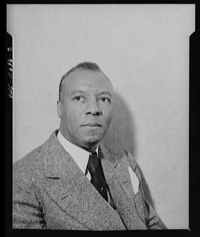 A. Philip Randolph. Asa Philip Randolph (1889 - 1979) was a prominent civil rights and labor leader. He was founder of the Brotherhood of Sleeping Car Porters in 1925 and the March on Washington Movement. Randolph was also an editor of the socialist black magazine The Messenger. In a 1919, he co-wrote with Chandler Owen an editorial in that magazine in which they urged self-defense to prevent lynchings and mob violence: "Anglo Saxon jurisprudence recognizes the law of self-defense. Our information also records that the right of self-defense is recognized in the laws of all countries. ...We are consequently urging Negroes and other oppressed groups confronted with lynching or mob violence to act upon the recognized and accepted law of self-defense. Always regard your own life as more important than the life of the person about to take yours, and if a choice has to be made between the sacrifice of your life and the loss of the lyncher's life, choose to preserve your own and to destroy that of the lynching mob." Library of Congress Prints and Photographs Division, LC-USW3-011696-C. |
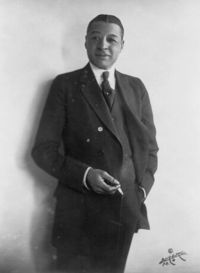 Egbert Austin Williams [between 1921 & 1922]. Bert Williams (1875 - 1922) was one of the most successful black comedians and entertainers of his time. During his closing argument in the Henry Sweet trial, Prosecutor Robert Toms tried to show that he was not prejudiced. He said at one point: "But I want to tell you this, that among my pet prejudices, I do not hold one against the negro. I have known some fine negroes. I once ate dinner with Bert Williams, and spent the evening with him; as delightful an evening as I ever spent." Library of Congress Prints and Photographs Division, LC-USZ62-64934. |
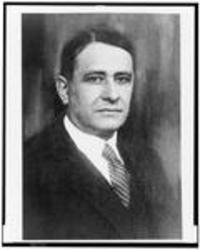 Arthur B. Spingarn. Arthur Barnett Spingarn (1878 - 1971) was a lawyer and civil rights leader. He was the chairman of the NAACP National Legal Committee during the Sweet trials. Other sources state that he was President of the NAACP National Legal Committee from 1940 - 1957. He was President of the NAACP from 1940 - 1965. After the Sweets and the other defendants were arrested and charged with murder, the NAACP worked to find top notch lawyers to defend them. A committee consisting of James Weldon Johnson, the first black secretary of the NAACP, Walter White, assistant secretary of the NAACP, Arthur Spingarn, and Charles Studin went to meet with Clarence Darrow to try and convince him to take the case. Library of Congress Prints and Photographs Division, LC-USZ62-110586. |
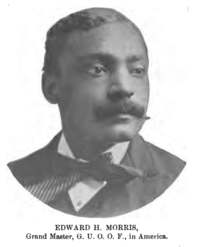 Edward H. Morris (1858 - 1943) c. 1902. Edward Morris was born in Kentucky, the son of a slave, and later became one of most successful black attorneys in Chicago. He was only the fifth black to pass the Illinois bar. Morris became good friends with Clarence Darrow and worked with Darrow to defend Oscar DePriest. Morris was elected to the Illinois General Assembly in 1891 as a Republican. He also served as the attorney for the town of South Chicago in 1892 and 1896, and in 1895 served as an assistant attorney for Cook County. Morris helped several young black lawyers and law students including Fredrick L. McGhee, who in 1885 went into practice with Morris, who by that time was referred to as Chicago's "dean of colored lawyers." McGee later moved to St. Paul, Minnesota and became the first black lawyer admitted to the bar in Minnesota. McGee went on to become an important civil rights advocate. The G.U.O.O.F. under Morris's name refers to the Grand United Order of Odd Fellows, a fraternal organization founded in 1843 for black members with a charter from the Grand Lodge in Manchester, England. Photo from: The Official History and Manual of the Grand United Order of Odd Fellows in America: A Chronological Treatise ... by Charles H Brooks (1902). |
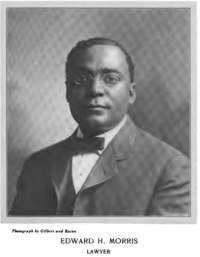 Edward H. Morris c. 1903. Edward H. Morris was a prominent Chicago attorney and politician. Clarence Darrow was a friend and colleague of Morris. Darrow publicly spoke out in support of Morris when he believed Morris was unfairly treated because of his race by a committee of the Chicago Bar Association. The committee issued a report on candidates for judges in which it said Morris was not fit for the bench and also mentioned that he was colored. Darrow wrote a letter in November 1923 to the editor of The Broad Ax, a black Chicago newspaper, in which he protested the "unfair treatment received by Edward H. Morris at the hands of the Chicago Bar Association and its committee." Darrow accused the committee of being prompted "solely" by Morris's color and he praised Morris's ability: "I know of no man on either ticket who is better qualified or whom I believe would make a better judge, and I trust that the colored voters of this City will give him such a vote as emphatically to show their disapproval of the report and the action." Photo from Appleton's Magazine (1903). |
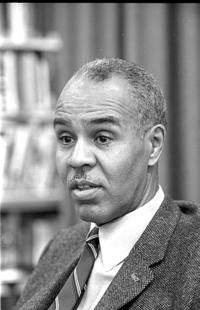 Roy Wilkins, Executive Secretary of the NAACP. In his posthumously published autobiography, Roy Wilkins wrote "Darrow was an agnostic who didn’t acknowledge the divinity of Christ but who honored the Golden Rule far better that [sic] most white Christians, and he won the case. One night, while the jury was still out, I went down to the Kansas City Star to see if any of the wire services had word of a verdict. It was the most important housing case of the twenties, but when I asked a white news editor about the story, he looked up at me blankly and mumbled, “The Sweet Case? Never heard of it." Roy Wilkins, Tom Mathews, Standing Fast: The Autobiography Of Roy Wilkins, 64 (1994). Library of Congress Prints and Photographs Division, LC-DIG-ppmsc-01273. |
 Jesse Binga. Jessie Binga was a prominent black banker in Chicago who lost everything due to the Great Depression and a conviction for embezzlement. In 1933, Binga was convicted of embezzling $22,000 and sentenced to 10 years in prison. Clarence Darrow knew Binga for about thirty years. The New York Times reported in Clarence Darrow's obituary in March 1938 that "Mr. Darrow's last recorded act on behalf of unfortunates occurred March 31, 1936, when he drove to the Illinois State Penitentiary at Joliet, accompanied by a priest and two nuns, to appear as a witness before a subcommittee of the State Parole Board to urge the release on parole of Jesse Binga, 71-year-old Negro ex-banker serving a one to ten year sentence on a charge of embezzlement." But it was not until 1938 that the work of Darrow and other Binga supporters gained Binga's release. Binga lived twelve more years, eking out an existence as a janitor. Photo is from The Crisis (1921). |
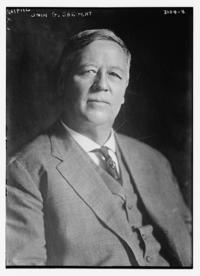 John G. Sargent. John Garibaldi Sargent (1860 - 1939) was the Attorney General of the United States from 1925 to 1929. In 1939, Samuel Moore, an African-American prisoner in the Federal Penitentiary in Atlanta, wrote a letter to Ruby Darrow asking her if she had anything to help substantiate a promise that Attorney General Sargent made to Ruby and Clarence Darrow in regard to Moore's parole. Library of Congress Prints and Photographs Division, LC-DIG-ggbain-16331. |
 Provident Hospital. Provident Hospital, the first interracial hospital in the United States was founded in Chicago in 1891. One of its principal founders was Dr. Daniel Hale Williams (1856 - 1931). Williams was a surgeon and is considered to be the first African-American cardiologist. For a time, Williams was Clarence Darrow's personal physician. Darrow supported Provident Hospital and served on its board. Photo from The Crisis (1915). |
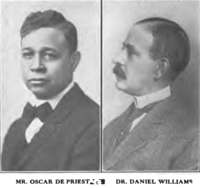 Oscar DePriest and Dr. Daniel Hale Williams. Clarence Darrow was friends with both Oscar Depriest and Daniel Hale Williams. Oscar DePriest (1871 - 1951) was born in Alabama to former slaves and became Chicago’s first black alderman. Darrow successfully defended DePriest in 1917 when he was tried on conspiracy charges for allegedly protecting illegal gambling and prostitution operations. In 1928, DePriest was elected to Congress as a member of the Republican Party. He became the first black elected to Congress since Reconstruction. Daniel Hale Williams (1856 - 1931) was an American surgeon and is considered to be the first African-American cardiologist. For a time, Williams was Clarence Darrow's personal physician. Williams is credited with performing one of the first successful heart surgeries in 1893. He also founded Provident Hospital, the first non-segregated hospital in the United States in Chicago in 1891. Photo from volume 10 of The Crisis (1915). DePriest Letter to Darrow |
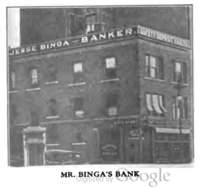 Jesse Binga's Bank. Published in The Crisis (1915). |
 John G. Sargent. John Garibaldi Sargent (1860 - 1939) was the Attorney General of the United States from 1925 to 1929. In 1939, Samuel Moore, an African-American prisoner in the Federal Penitentiary in Atlanta, wrote a letter to Ruby Darrow asking her if she had anything to help substantiate a promise that Attorney General Sargent made to Ruby and Clarence Darrow in regard to Moore's parole. Library of Congress Prints and Photographs Division, LC-DIG-ggbain-16331. |
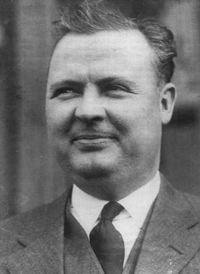 David Curtiss (D.C.) Stephenson. D. C. Stephenson (1891 - 1966) was a former Grand Dragon of the Indiana Ku Klux Klan and 22 other northern states. As leader of the Klan, Stephenson had become very politically and financially powerful. There is hardly any mention in any historical or contemporary account of Clarence Darrow's legal career that in 1931 Darrow joined Stephenson's defense team during appeals to get him released from prison. The events leading to Stephenson's legal troubles began on the evening of March 15, 1925 when Stephenson and some of his henchmen kidnapped Madge Oberholtzer, a 28 year-old schoolteacher, whom Stephenson had occasionally dated during the preceeding two months. Oberholtzer was forced to drink whiskey, forced onto a train to Chicago where in a private train car she was brutally raped and bitten all over her body by a drunk and demented Stephenson. She was held captive in hotel for nearly two days during which she attempted suicide twice, once with a gun and once by ingesting Bichloride of mercury. When Oberholtzer became very ill her kidnappers decided to drive her back to Indianapolis. At one point Oberholtzer threatened Stephenson with arrest at which he allegedly laughed and told her "I am the law." Oberholtzer was eventually taken to her home and sought medical attention. But her condition worsened and on March 28 she described the crime she suffered at the hands of Stephenson. She died on April 14 from infection and kidney failure due to mercury poisoning. Stephenson was arrested, tried and on November 16, 1925 he was convicted of murder in the second degree and sentenced to life imprisonment. On July 7, 1931 the Chicago Daily Tribune reported that Clarence Darrow had joined Stephenson's defense to help in his appeals to get out of prison. The story noted that Darrow's appearance before the Indiana Supreme Court was prevented when the attorneys agreed to file written briefs instead of give oral arguments. In January 1932 the Supreme Court of Indiana affirmed Stephenson's murder conviction. The kidnapping and murder of Oberholtzer was so shocking it helped end the rise of the KKK in Indiana. Stephenson was paroled on March 23, 1950, but violated parole by disappearing around September 1950. Stephenson moved to Robbinsdale, Minnesota where he was arrested on November 11, 1950. He was held in the Hennepin County jail for about a year while he fought extradition to Indiana. The Supreme Court of Minnesota ruled against Stephenson in November 1951 and he was sent back to Indiana. In 1951 he sentenced to serve another 10 years in prison. On December 21, 1956, Stephenson was given a Christmas clemency with dozens of other prisoners but this was conditioned on his leaving Indiana and never returning. In 1961, he was arrested on charges of sexually assaulting a sixteen-year-old girl in Missouri. Sources differ with some saying the charges were dropped, some saying he was fined and others saying he was sent to prison but was paroled in November 1961. Letters between Stephenson and Clarence Darrow. Photo from: http://en.wikipedia. org/wiki/File: David_Curtis_Stephenson.jpg 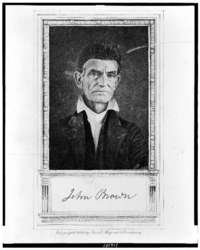 John Brown. In 1928 Clarence Darrow and his son Paul sold their stock in Greeley Gas & Fuel Company in Colorado and made a large profit. Darrow believed that he and his wife were now financially secure and could enjoy a good retirement. Both son and father invested their profits in the stock market. Thinking he was financially secure for life, Darrow arranged for a portion of his lecture fees to go to the NAACP and a smaller percent to go towards a monument to the abolitionist John Brown. His gift to the NAACP was substantial since he was popular enough as a speaker to command $500 to $1,000 per program. But Darrow's retirement plans would suffer financial catastrophe in the 1929 stock market crash. Library of Congress Prints and Photographs Division, LC-USZ62-106337. |

